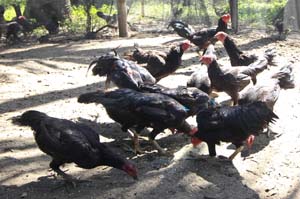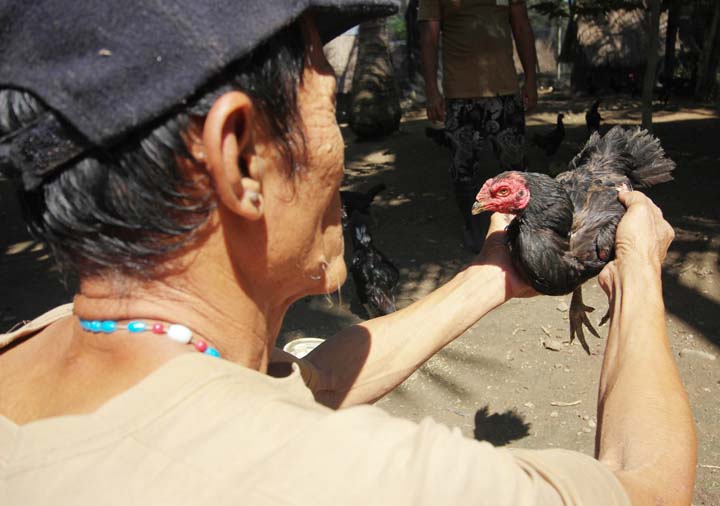The native livestock production is a growing industry in many regional areas in the Philippines. Particularly the native chicken industry, it is seen with much potential as it drives consumers to get quality local products from local farms. More important, it gives opportunities to local communities to earn with lesser capital and encourage rural enterprises through the production of healthier livestock products.
The native chickens underwent a sort of purification in recent years, thanks to the efforts of researchers from different institutions and with the help of the Department of Science and Technology-Philippine Council for Agriculture, Aquatic and Natural Resources Research and Development (DOST-PCAARRD).

According to Dr. Synan Baguio, DOST-PCAARD’s OIC for Livestock Research, there are six native chicken breeds that have been purified. These are the Banaba chicken in Southern Tagalog, the Camarines chicken in Bicol, the Darag chicken in Panay Island, the Boholano chicken in Bohol, the Bolinao chicken in Ilocos region and the Zamboanga Peninsula (ZamPen) native chicken in Zamboanga.
“We are currently working on the Patani chicken in Caraga,” Baguio said. “These are the native chickens with darker meat color and are already recognized in their respective areas.”
Collaboration with San Ramon Prison
At Western Mindanao State University (WMSU), through the leadership of ZamPen native chicken has been making waves as it has not only attracted local farmers in the region but also has a collaboration with the San Ramon Prison and Penal Farm (SRPPF) in Zamboanga City.
The project, titled “Evaluation of the Sustainability and Profitability of ZamPen Native Chicken Production as a Source of Livelihood in Rural Communities,” was recognized at the National Symposium on Agriculture, Aquatic and Natural Resources Development (NSAARD) in the development category.
It has showcased the capability of ZamPen native chicken to be a sustainable livelihood for rural communities in the peninsula and give hope to SRPPF inmates who will soon be starting a new life.
Purification process
By using the phenotypic or observable characteristics, Narvaez’s team took 120 stocks all over the Zamboanga Peninsula for the pure Joloanon strain, or the ZamPen native chicken.
“It took us four months for our preliminary investigation of all the Joloanon strain,” Narvaez said.
She explained that they interviewed the sources of the chickens, looked over their practices in raising the chickens and took into consideration the years they have been raising them.
“The chickens had random mating and we had to separate those who had off colors from the black color plumage [feather] of pure ZamPen chicken,” Narvaez added.
She said the separated chickens were still subject to observation since over the months that they will grow, some chickens would still change in color.
After six months of maturity, Narvaez finally selected the male chicken that stood out among the rest and had it mate again with female chickens.
The same process was done with the subsequent generation of chicken until the same phenotypic characteristics were observed. This is called the back-crossing method.
“We select until the percent of purity [of the breed] has reached a higher number. This was based on the number of chicks produced with a high resemblance to the same plumage color,” Narvaez explained.
Right on the third cycle of back-crossing, the team succeeded in obtaining uniformity of color and weight.
In 2015 Narvaez, through the WMSU research, started to release the pure Joloanon strain chickens, or the purified ZamPen native chickens, to local farmers. She wanted to check on the genotypic characteristics but decided it was not needed.
Capacity building for prison inmates
The native chicken project was set to be shared to other beneficiaries. However, Narvaez chose SRPPF as its subsidiary.
“After the verification and purification process, we collaborated with the penal farm because, as an academic institution, WMSU could not do a full-blast production,” she said.
The university didn’t have enough land space and the penal farm was a perfect site.
“We catered to inmates who were about to be released. We scheduled their training because they are not allowed to leave the compound if not accompanied by prison guards,” she added.
The team trained 30 inmates in two batches. They had a two-day training and later went to the field to start raising the chickens.
“The purpose why I chose them [inmates] is for capacity building,” Narvaez said.
She explained that if the inmates were released from prison, they will be given a breed starter composed of five female and one male ZamPen native chickens.
Each chicks sold in the penal farm costs P100 each. The inmates receive a salary for their job.
Next steps
Narvaez is currently looking for ways to commercially produce feeds suitable for the ZamPen chickens.
“We have to formulate our own feeds for the chicken because we only mix feeds and it is definitely laborious,” she lamented.
She explained that if there are feeds commercially available in the market and designed for native chickens with local ingredients, it would make the work for chicken farmers a lot easier.
“[The feeds should be] high in protein, with carbohydrates, iron, the usual [components] and locally produced,” she added.
The ZamPen chickens are currently fed with a mix of commercial feeds and kitchen excess, which is not purely organic.
According to Narvaez, “we want it phased out soon.”
Tied to Philippine culture
Baguio reiterated that having purified native chickens gives identity to the Philippine culture.
“We are sowing the development of native chickens to our own culture. It must be supportive to the local culture itself, where it is being grown, because these are our own domesticated animals that originated in our own lands,” Baguio said.
The demand for native chickens are already high and it’s being sold in many areas around the country.
However, raising the chickens must be done only in their places of origin. The reason is that it is not assured if the native chickens can survive and produce properly in different environments.
Having native chickens in their areas of origin is also easier for farmers to raise them because of their adaption to the environment, and cheaper cost of labor and resources.
“Although native chickens take more time to grow, it is definitely healthier and tastier,” Baguio added.
They are fed with kitchen excess and forage materials, such as vegetables, which add natural flavor to their meat, he said.
Compared to commercially raised chickens that are grown for only a month and sold in the market, native chickens need 14 weeks to 16 weeks to mature and be sold.
“There’s a stark difference in raising [commercial and native chicken] but it is compensated with the price when sold in the market,” Baguio said.
Each native chicken fetches between P250 and P300 each.
Another purpose in the development of native chickens is the preservation and conservation of the local animal genetic resources.
Baguio said, “We want to keep and develop the unique preferences of different chicken ethnic groups.”
Image credits: Stephanie Tumampos

































